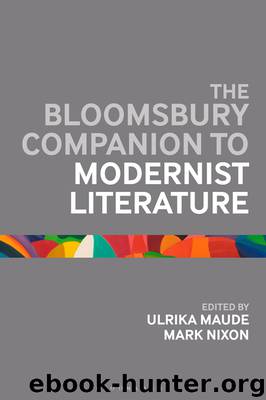The Bloomsbury Companion to Modernist Literature by Ulrika Maude Mark Nixon

Author:Ulrika Maude,Mark Nixon
Language: eng
Format: epub
Publisher: Bloomsbury UK
16
Modernism, Psychoanalysis and Other Psychologies
Laura Salisbury
‘[C]himney-sweeping’. This was Fräulein Anna O’s joking description of the new treatment for hysterical symptoms she was undergoing in the 1880s with Dr Josef Breuer. In more serious moments and perhaps more memorably, she referred to the nascent practice of psychoanalysis as the ‘talking cure’ (Breuer, 1893, 29), thus underscoring psychoanalysis’ insistent link to linguistic modes and representations. But as Breuer’s collaborator, Sigmund Freud, was later to suggest, perhaps the joke reveals as much as the more sober account, given the comic’s capacity to carve routes into material the mind cannot and will not face straight on. Though chimney-sweeping implies a rather routine operation – something like spring cleaning – condensed within the image is a much less homely, more unheimlich, or uncanny idea. If the house can be taken as an image of the self, the chimney is a hidden space that cuts through the core of the building. Though central to the functioning of the home, inside the house the chimney is only visible via contours and bulges. The chimney is necessary for the hearth’s cosy warmth, but it is also clogged with the soot and smut that are the precipitates of a fire that might stand for civilization itself. Darker still, the chimney in the nineteenth century could have held for Anna O the ghost of a deathly space – a site of child labour and abuse. But there is a glimmer of the folk erotics and romance of the ‘lucky’ sweep, too, which perhaps prefigures Anna O’s developing desires for her doctor. The unreasonable strength of these feelings would frighten Breuer away from psychoanalysis and into a second honeymoon with his wife, but for Freud they became the bedrock of psychoanalytic technique through the attempt to understand the patient’s transference of earlier modes of relating on to their doctor.1 As Stephen Frosh has it, psychoanalysis admits that ‘[s]omething lives at the heart of the human subject, outside the realms of normal egoic control, something not-I’; but what distinguishes the Freudian unconscious is its dynamic character – it is something ‘present, active, pushing for expression, motivating, causal’ (2003, 118). A blockage in a chimney can burn down the whole edifice.
Of course, it would be impossible to unpick the metaphor of ‘chimney-sweeping’ in this way without the psychoanalytic processes of interpretation Anna O was beginning to name. And one of the reasons why psychoanalysis became the dominant accent in cultural accounts of the mind by the middle of the twentieth century, and why it has been the most significant way of using psychology to read literary modernism, is precisely Freud’s emphasis on representation and interpretation. Freud’s focus on representation has its root in the idea, expressed in The Interpretation of Dreams (1900; published in English in 1913) and brought back to the centre of psychoanalysis in Jacques Lacan’s work in the 1950s, that the unconscious is structured like a language (Lacan, 2007). For Freud, the human organism desires the production of its own
Download
This site does not store any files on its server. We only index and link to content provided by other sites. Please contact the content providers to delete copyright contents if any and email us, we'll remove relevant links or contents immediately.
4 3 2 1: A Novel by Paul Auster(11064)
The handmaid's tale by Margaret Atwood(6865)
Giovanni's Room by James Baldwin(5888)
Big Magic: Creative Living Beyond Fear by Elizabeth Gilbert(4730)
Asking the Right Questions: A Guide to Critical Thinking by M. Neil Browne & Stuart M. Keeley(4588)
On Writing A Memoir of the Craft by Stephen King(4219)
Ego Is the Enemy by Ryan Holiday(3999)
Ken Follett - World without end by Ken Follett(3979)
The Body: A Guide for Occupants by Bill Bryson(3811)
Bluets by Maggie Nelson(3718)
Adulting by Kelly Williams Brown(3678)
Guilty Pleasures by Laurell K Hamilton(3590)
Eat That Frog! by Brian Tracy(3521)
White Noise - A Novel by Don DeLillo(3438)
The Poetry of Pablo Neruda by Pablo Neruda(3370)
Alive: The Story of the Andes Survivors by Piers Paul Read(3317)
The Bookshop by Penelope Fitzgerald(3234)
The Book of Joy by Dalai Lama(3223)
Fingerprints of the Gods by Graham Hancock(3218)
